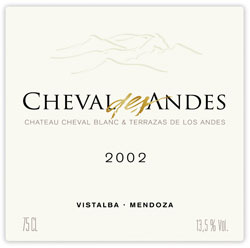A recent visit to Argentina filled me with excitement for what is to come in Argentine wines. Not that you can't find plenty to enjoy in the wines today--but the potential is so much greater even than the pleasures that today's wines offer. Argentina seems to be a land destined to make some great wines. Michel Rolland must have thought so, in investing in the Clos de los Siete winery. And Pierre Lurton of Château Cheval Blanc must have thought so, too, in creating Cheval des Andes.
 Cheval des Andes is a wine produced at Moët Hennessy's Argentine winery, Terrazas de los Andes. It represents a joint venture between Terrazas and Cheval Blanc and is crafted jointly by Lurton and Terrazas winemaker, Roberto de la Mota. It is the first joint venture ever for Cheval Blanc, one of the two most elite premier grand cru classé wines from St. Emilion, in Bordeaux. Lurton, who is president of Château d'Yquem as well as director of Cheval Blanc, is said to have been intrigued with the possibility of making Malbec, as that grape was one of the most important varieties in St. Emilion prior to the phylloxera outbreak in the 1860s.
Cheval des Andes is a wine produced at Moët Hennessy's Argentine winery, Terrazas de los Andes. It represents a joint venture between Terrazas and Cheval Blanc and is crafted jointly by Lurton and Terrazas winemaker, Roberto de la Mota. It is the first joint venture ever for Cheval Blanc, one of the two most elite premier grand cru classé wines from St. Emilion, in Bordeaux. Lurton, who is president of Château d'Yquem as well as director of Cheval Blanc, is said to have been intrigued with the possibility of making Malbec, as that grape was one of the most important varieties in St. Emilion prior to the phylloxera outbreak in the 1860s.
Cheval des Andes is a blend of Cabernet Sauvignon (56%), Malbec (40%) and Petit Verdot (4%) from the high-altitude Las Compuertas vineyard in the Vistalba district of Mendoza province. The Malbec vines in this vineyard are 76-years old and are ungrafted. The blend varies somewhat from year to year; in 1999 and 2002, for example, the wine was 60 percent Cabernet and contained no Petit Verdot.
This wine does indeed reflect its dual citizenship. Its Malbec component dominates in the aroma and flavor, offering fresh notes of spice, black cherry and cedar, and marking the wine clearly as a product of Argentina. But, true to its European heritage, the wine is genuinely dry, has aromas and flavors that are not as intense as you would expect from Argentina, and is at least as much about structure as it is about flavor. Like Cheval Blanc itself, this wine is soft and approachable. Its tannins are ripe and ample, and yet the wine is lean more than it is plump, at least at this stage of development. Concentrated black fruit on the finish promises years of development ahead.
Plenty of delicious Argentine wines today offer ripe, abundant fruit delivered through modern winemaking and, in the top wines, choice oak. But not many offer restraint or sophistication. This wine stands out for just that.
The 2002 Cheval des Andes is the second vintage of this wine available in the U.S., and it comes from an excellent vintage for Argentina. The 2001 is a bit more delicate and less expressive; the 1999, tasted in Argentina, is the plumpest and most clearly molded in a New World profile of the three.
This 2002 is still very young. To enjoy it now, give the wine aeration and use large Bordeaux-type glasses. It will probably be more enjoyable yet in two years, and most likely will offer another 12 to 15 years of good drinking beyond that.
Outstanding: 90